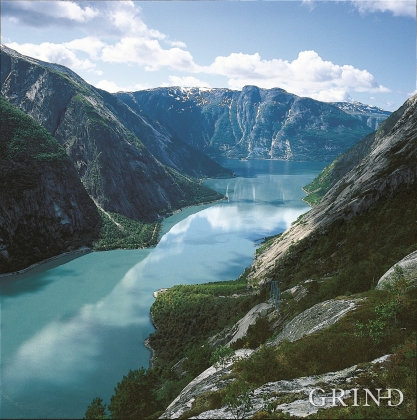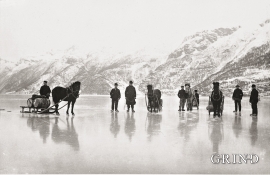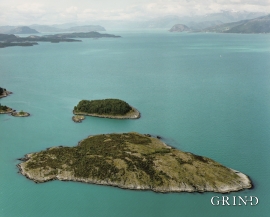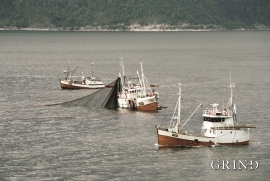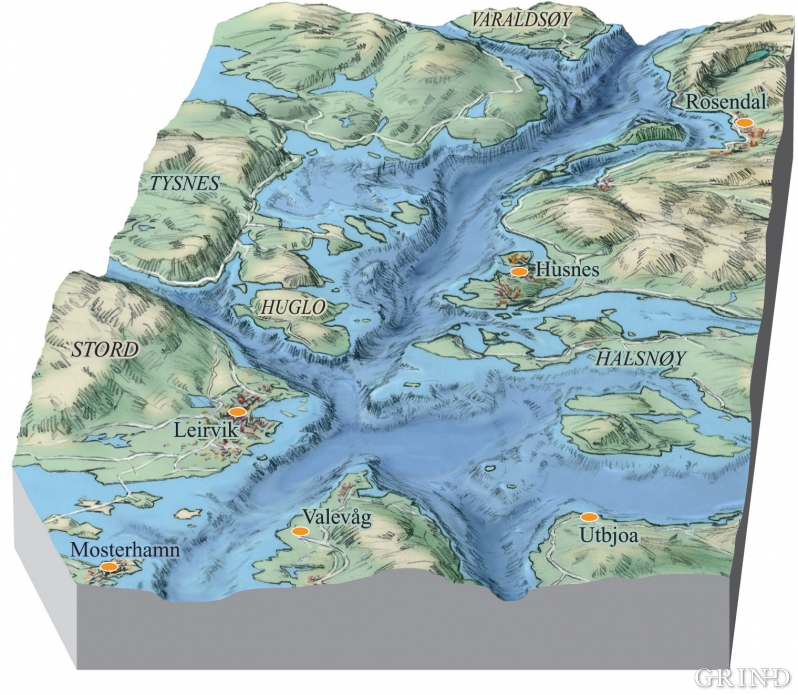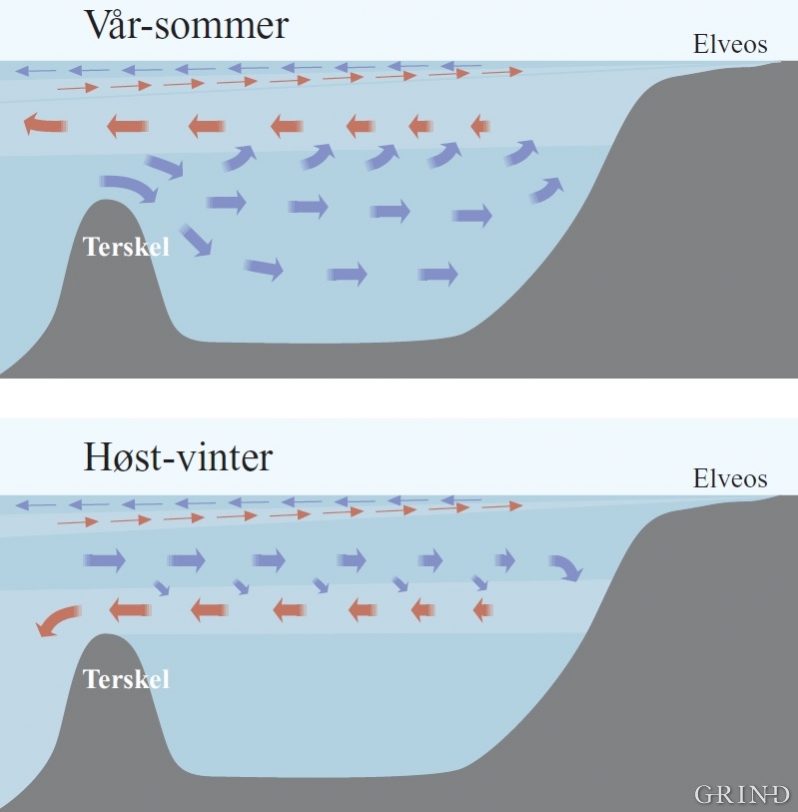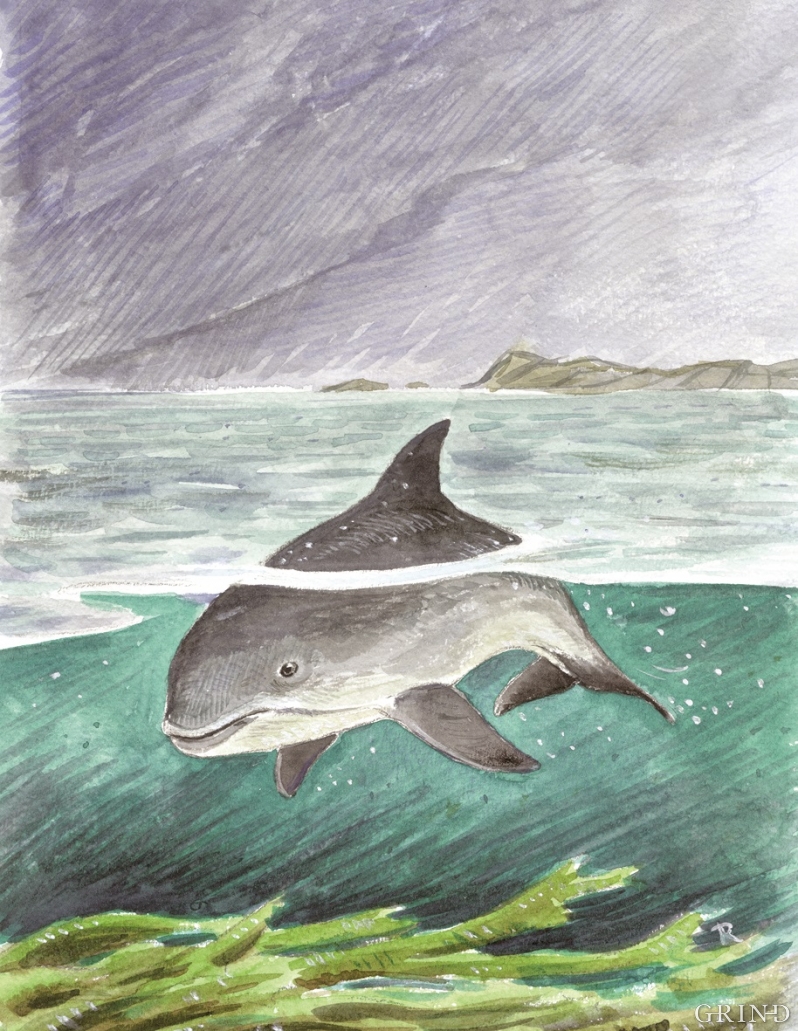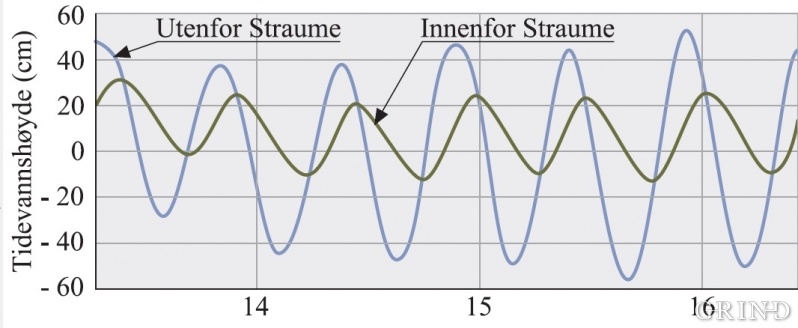Published: 28.10.2004 | Author: Herman G. Gade
Fra Kjeåsen mot Simadalsfjorden. (Helge Sunde)
About water and the physical processes in the underwater landscape
The West Coast of Norway, with its deep fjords that carve far into the high mountains, is one of the most characteristic and - many would say - beautiful landscapes in Europe. It is not without reason that tourists come from around the world each year to see the fjords of Norway.
Hordaland has a vast number of fjords; the longest of them, Hardangerfjord, is an enormous fissure that stretches 150 kilometres inland from the ocean. Most of us have a picture in our minds of a typical fjord landscape, but do we understand what it is that characterizes a fjord, and what is happening in the water masses? How does the fjord look under water? And how are the tides felt in the inner parts of the fjord?
An underwater valley
A fjord can be described in simplest terms as an underwater valley, a deep gorge that extends under sea level and which, farthest out, often falls off steeply to the ocean. This is perhaps better envisioned if we think of the landforms we see where fjords rise up on dry land, as valleys. The valley bottom here rises either evenly or stepwise into the high mountains. But most do not know what happens under water. A hundred years of research has given us a better understanding of what the fjords look like at depth, which sediments lie on the sea bottom and which processes are active in the different layers of water.
Typically, this kind of landscape will be U-shaped in cross-section. This reflects that the fjord once had been carved out by an arm of a glacier. Where the glacier arm temporarily ceased its calving, usually where the bedrock formed raised areas on the sea bottom, end moraines were laid down. These created underwater barriers known as sills. Today, these sills restrict the water exchange between the fjord and the ocean beyond.
For example, Hardangerfjord is more than 850 m deep in its main arm between Kvanndal and Øystese, but only 190 m at its sill south of Huglo. For over a thousand years the rivers have deposited silt and clay particles and these have created a thick layer on the fjord floor. These sediments have largely flattened out the U-shaped profile. The largest amounts, probably over 95%, were laid down when the glaciers in the fjords first melted back, but also after the ice had melted, and up until today, layer by layer of fine sediment settles to the sea floor.
A fjord in West Norway is seldom a simple "valley bottom", but rather a complex system with many fjord arms. The physical conditions can vary from one arm of the fjord to the next. The depths vary also, and some have more pronounced sills than others. Depending on the fresh water supply and wind conditions some arms of the fjord will often freeze in winter - others more seldom. There are also other factors that determine the movements and quality of fjord water: variations in temperature and salt content, influence from tides and the earth's rotation, natural chemical reactions, and - in our own time - pollution.
Layers of water
The water in a fjord consists of many layers, each with its own characteristics. Movement is greatest in the surface layer; at greater depth in the fjords the water can be stagnant over long periods. It is first and foremost the sills at the mouths of the fjords that limit the free flow of water between the fjord and open ocean, and this hindrance is largely responsible for the distinctive layering of the fjord water.
The vast majority of fjords receive a supply of fresh water from rivers. This fresh water gets mixed with sea water to form brackish water that slowly seeps out toward the mouth of the fjord and the ocean. Initially, this brackish water current is shallow and quite fresh. The mixing with sea water from below occurs rapidly, however, and within just a few kilometres from the river mouth the brackish water already has a much higher salt content. This current therefore transports much more seawater than freshwater - in Hardangerfjord it transports 7 times as much saltwater as freshwater, and in Byfjord 6 times as much.
The mixing and outflow of seawater with the brackish water generates an undercurrent of new seawater from outside the fjord, also called a counter-current or undercurrent. The counter-current is usually 2-3 times as thick as the brackish water current, but it flows correspondingly slower. It carries nutrients and oxygen from the coastal waters and is therefore important for biological productivity in the fjord. Taken together, the brackish water current and the counter-current create a circulation pattern that is critical for life in the fjord.
The vital middle layer
Most of the fjords in West Norway, with few exceptions, have deep sills of over 100 metres. Inwards from the sea there is a water layer that stretches from the underside of the counter-current down to the depth of the sill. This middle layer is in direct contact with the coastal water outside and is therefore strongly influenced by the exchange of fjord water with this coastal water. Several mechanisms contribute to this.
Fresh water is lighter than salt water. Together with temperature, the salt content of the water determines its density. During the course of a year the density of the water both inside and outside of the fjord changes, at different rates at different times. Because of the large amounts of fresh water in the Baltic Current outside the coast and the fresh water flow from land, the coastal water in autumn and early winter will be lighter than the middle layer of the fjord water inside. With the help of southerly winds at this time of year, together with the earth's rotation pushing the coastal current to the right, the lighter coastal water flows into the fjords. The heavier fjord water in the middle layer flows simultaneously out, under the lighter coastal water on its way in.
In the spring these conditions reverse; the density and salt content of the coastal current increases and becomes heavier than the middle layer in the fjord. The currents change places: the middle layer creeps upwards and flows out over the coastal water on its way in. Similarly as for the circulation between the brackish water current and counter-current, the seasonal flushing of the middle layer is of great importance for renewing and aerating the fjord water. These processes are crucial biologically because they supply large amounts of oxygen and help to maintain the diversity of smaller organisms and plants that live in the water masses, the plankton. This was first discovered during marine biological studies in Hardangerfjord.
The water out-flushing also helps to prevent the accumulation of nutrients or pollution in the fjord systems. It is nonetheless clear that the quality of water that comes in from the ocean is not better than the quality of the "source waters" in the North Sea, Skagerrak and the Baltic Current from the Baltic Sea. The fjords are therefore vulnerable to extensive pollution from these waters.
Still water in the deep fjord bottoms
The deep water below the level of the sill in the fjord is isolated from the free exchange with the coastal water, and it is therefore especially vulnerable to pollution and increasing amounts of organic material that consumes oxygen. In many fjords this is a big problem, and there has therefore been much interest in the processes that flush out the deep water from under the level of the sill.
As we have seen, the summer coastal water flows in over the sills to the large fjords of Hordaland - Hardangerfjord, the Byfjord system and Fensfjord - which all have sills between 100-200 metres deep. This water tends to be somewhat heavier than the deep water from the fjord. It will therefore sink down and displace most or all of the deep water and breathe life into the great fjord at depth.
The same occurs in the fjords with shallower sills, but here there is less exchange with coastal water and it occurs only once a year. The heavy water seeps in over the sill and renews the fjord water only when the density of the shallower layers of coastal water is at its highest, from mid- to late winter. Then, the temperature conditions are at their coldest, and much fresh water is bound up in snow on land, so there is little water in the rivers at the same time as the coastal water is both colder and saltier, and therefore denser otherwise. A number of smaller fjords and fjord arms in Hordaland have shallow sills and therefore behave in this way. Arnavågen, Radsundet and several basins along Osterfjord, all with sill depths of less than 10 m, receive their main renewal of water once a year. Nordåsvatnet, Lindåsosene and Store Lungegårdsvann are among these, but here the inflow sill is so shallow that the water renewal in winter often fails or occurs only to a minimal degree.
Depleted Oxygen supply and “rotten water”
If the water renewal fails, the deep water will usually become depleted in oxygen, which can lead to the formation of hydrogen sulphide (H2S). There is a danger of this especially in the fjord arms that have both shallow sills and also a significant supply of fresh water. The best place to study this phenomenon in Hordaland is the inner basin in Mofjorden, where the sill is ca. 3 m.
Today, we have technical methods of creating turbulence in the water masses and in that way “giving artificial respiration" to the fjord systems that have bad circulation. The most common method is to inject fresh water from a submerged source. At several places, such as Byfjorden, this occurs through the underwater injection of water from hydroelectric plants, industry, cities or other human settlements. There is much to suggest that this method could be used on a considerably larger scale than is the case today. The injected water draws with it deep water with nutrients that can increase primary production in the uppermost layers. The method was suggested as a means of increasing the growth season for mussels in Hordaland and to keep toxic algae away from the mussel plants. Another effect of the submerged discharge of fresh water is that it hinders the formation of ice on the fjord in winter.
Tidal waves - gravitation from the sun and the moon
When the wind blows, we look for bigger and smaller waves on the sea surface. The more the wind blows, and the longer the period of time, the larger the waves. Most of us do not reflect upon that the tides also can be viewed as waves. In this case the distance between the wave crests is so large that we do not see the wave, just that the water rises and falls between low and high tide. The tidal water in the fjords is the result of tidal waves that build up in the large oceans due to the forces of the sun and the moon. In West Norway these waves come in from the Atlantic Ocean and are felt nearly simultaneously along the whole coast of Hordaland. If we look more closely, we find that there is a delay of some minutes northward, so that high tide in Askvoll in outer Sogn arrives 10 minutes after Espevær in Bømlo, further south. From the outer coastal regions the tidal waves travel inward in the fjords.
The tidal waves actually consist of both longer and shorter waves, but all of them are so long that they take more than three hours, and at most up to a whole day, from wave crest to wave crest. It is the wave that takes a half of a day that dominates here: This wave creates what we call the semi-diurnal tide - where the time from high tide to high tide or low tide to low tide is 12 hours and 25 minutes. The ocean also has shorter tidal waves with roughly 6, 4, and 3 hour distances between wave crests. These waves develop in shallow seas such as the North Sea and are felt all along the coast, but they are usually so weak that they are barely noticeable. Inside of the Huglo sill in Hardangerfjord there is a remarkable phenomenon where the 4-hour wave that comes in from the North Sea occurs simultaneously with the natural "rocking back and forth” of the Hardangerfjord water - these two waves reinforce each other and create a larger 4-hour wave than normal. In Lukksund between Onarheimsfjord and Bjørneford the tidal currents therefore change direction every other hour (Tysnes R293).
High tide two hours late
When the tidal water spreads inward over the fjord and sound, it travels quite quickly most places. Even in innermost Eidfjord, more than 150 kilometres from the coast, high tide occurs only 38 minutes after Espevær to the south in outermost Bømlo. This corresponds to a speed of 200 kilometres per hour. The tidal water may take a bit longer in other places because the ocean water is shallow or because the fjord mouth is especially narrow. In the latter case there would also be less of a tidal difference. We can find many examples of this, but Nordåsvatnet near Bergen is perhaps the best known. High tide arrives here nearly two hours after the tide along the coast, and the tidal difference is less than half of normal. Similar conditions are also known in the Lindås inlets.
When the tidal waves reach the end of the fjord, they bounce back and create a wave that flows outward again. This means that everywhere in the fjord the water level will vary as if two nearly identical waves were present, but they move in opposite directions. These are known as standing waves . The simplest indicator of such standing waves is that the water level varies practically simultaneously everywhere in the fjord. This can be seen clearly in Hardangerfjord inward of the Huglo sill, where the difference in high tide between Husnes and Eidfjord is only 5 minutes, even though the fjord extends over 100 kilometres inland. Outside of the sill the tidal difference is significantly larger.
Varying differences in the tides
If the tidewater waves are not slowed by narrow or shallow sounds, as in Nordåsvatnet, the high and low tides will generally not differ by much. For standing waves, however, the tidal difference will be larger inwards in the deep fjords. This is especially noticeable where the fjords taper inwards. In Hardangerfjord, which is quite wide at the mouth and considerably narrower inland, this effect is pronounced - the average semi-diurnal tidewater difference increases from 60 cm in Espevær to 85 cm in Odda. A similar phenomenon is also seen at Osterfjord and Veafjord.
With the exception of Hardangerfjord, the tidewater difference inward along the open fjords is strikingly similar. A larger increase is observed northwards along the coast. If we again take Espevær as a starting point, with its 60 cm tidal difference, this discrepancy increases to 94 cm farthest north along the Hordaland coast. The tidal difference varies also according to the cycles of the moon. For Bergen, the tidal difference is on average from ca. 75 cm at neap tide (when the tidal difference between high and low tide is least) to ca. 1.2 m at spring tide (when the tidal difference is greatest).
The tides play an important role in the mixing and renewal of the fjord water. Even though the tidal currents are primarily a back and forth movement of water masses, they also cause eddies and turbulence that are important for the gradual mixing of the water masses.
Wind in the fjords
Not only the tides, but also the wind plays an important role in keeping the fjord water oxygenated, at least in the surface layers. The wind sets the water masses in motion and can transport them over large distances. The influence of the wind is largely determined by the topographic conditions above and below the water surface. Locally the wind might occasionally blow across the fjord, but for the most part it blows along its length. The wind blows inwards or outwards along the fjord, in the beginning as a quite shallow current, but eventually drawing more and more of the deeper water along, too. How deep these currents become depends on how strong and widespread the wind is and how long it lasts.
Central heating from the Atlantic Ocean
The Gulf Stream is not only responsible for the mild winters and ice-free conditions along the coast; its warmth gets transported into the fjords and ensures that they, too, are largely free of ice, a basic requirement for the fjord's central role in the transport of people and goods through the centuries. The winters along the shores of the fjords are also milder and shorter than one might expect so far inland. One need not travel further than Voss before the winter climate is considerably harsher than along Hardangerfjord.
The fjords of West Norway thus function as an effective mechanism of central heating, delivering a warming effect that can be felt 50-100 metres up along the valley sides. The fruit farmers in inner Hardanger could not boast the same cherry and apple harvests if they did not have the fjord as their nearest neighbour - the fruit trees are completely dependent on the large reservoir of warmth in the valley bottoms for the quality of their fruit. The fjord is especially important for buffering the difference between the day- and night-time temperatures, which gives a slower ripening process and better taste to the fruit.
"The fjord and all its life"
In his well written reflections of places and people of the fjords, Hans E. Kinck referred to the great fjord Hardangerfjord with his expression, “The fjord and all its life”. For our purposes, we can shift our view from the surface, to which Kinck's words refer, to the underwater landscape and the physical processes in the fjord systems, and the climatic effects of these large waterways inward toward the mainland. It is precisely the varied and complex interplay under the water's surface that gives us a basis for understanding the fjord as a "blue lung", of vital importance for both microorganisms and humankind.
Fjord ice
While the coastal waters are always free of ice, this is far from the case inside the fjords. Here, a cover of ice is quite common, but usually only in isolated areas and for shorter periods of time. Ice can only be expected on a yearly basis in the innermost parts of some fjords, and then not necessarily for the entire winter. Åkrafjord, parts of inner Hardanderfjord, Eidsfjord landward of Stamneshella and Mofjord are among these. In the outer fjord regions, however, the fjords can remain ice-free for many years in a row.
The most important condition for frequent ice formation is the existence of a layer of brackish water on the surface, which is the case in many inner fjord areas having a large fresh water supply. Brackish water is lighter than the salt water underneath. This hinders vertical mixing of the water masses. The cooling in winter will therefore be limited to a thin layer at the surface. This thin layer can easily freeze to ice. In addition, there are two conditions that especially promote ice formation: A light rain or snow that leaves behind a thin layer of fresh water or a crust of ice can be enough to start the process; but most importantly, there must be little wind, so that the warmer sea water does not get mixed upward. Eidfjord is an example of a fjord where ice formation is relatively seldom. Even though there is a stable supply of fresh water and a cold winter climate, the easterly winds from Hardangervidda Plateau prevent ice from forming.
After the rivers became regulated so that the water supply in winter many places increased significantly, the formation of ice increased also. Many places this became such a serious problem that measures had to be taken to lessen the process.
The prevention of ice formation can only be achieved by applying warmth, and this warmth can only be taken from the sea water itself. The simplest is to blow air in down at depth. When the air rises as thousands of tiny bubbles, it will carry warmth from the sea water, and the area will become ice-free. Another method, which is more effective, is to lead water from hydroelectric plants out at great depth so that mixing occurs between fresh water and sea water. This also carries warmth upwards in the water masses.
Turquoise fjord
In the spring and early summer of some years the surface water in some fjords is turquoise coloured. The colour is similar to that which is caused by meltwater from a glacier, but the explanation is different.
The reason for the colour in the fjord is a calcareous nannoplankton species, Emiliania huxleyi, tiny algae 5-6 µm in size that bloom in enormous numbers when the conditions are right. The algae are not toxic as are many other species, but when there are enough of them, they can adversely affect other life in the sea. Fish will often swim elsewhere, preferably to deeper waters. Perhaps it is precisely this phenomenon that some years causes the nesting of the terns to fail?
Algal blooms are stimulated by long periods of sunshine co-occurring with a large supply of fresh water. This phenomenon can be observed locally (Bergen R338), but some years large regions of the Hordaland coast can be characterized by turquoise water. 1993 was just such a year: a "carpet" of calcareous nannoplankton spread from inner Hardangerfjord to the sea west of Bømlo and Øygarden. In some fjords, such as Osterfjord, this phenomenon is very rare.
Although not documented, many who live along the coast believe that they observe a turquoise coloured sea more often, and over greater areas, now than before. Could this increase be due to a warmer climate and earlier spring? Or do the algal blooms coincide with the regulation of water ways and corresponding changes in the amount and timing of fresh water reaching the fjords? The questions are many and the consequences for the natural environment are unknown. Thus far it is the algal blooms that are toxic that have received most attention, since they are a threat to aquaculture along the coast.
Surplus or deficit of oxygen - life or death in the fjords
Production of algae in the seas and oceans occurs whenever there is sufficient light and nutrients. This forms the basis of the food web for animal plankton and higher life forms. Most of the plankton is consumed in the euphotic zone (0-30m), but a good deal sinks down and decomposes in deeper waters. Some also gets deposited on the bottom together with the silt from rivers. Decomposition is the breakdown of organic material into relatively simple organic and inorganic compounds (mineralization ). This process consumes oxygen. If there is a large influx of organic matter all of the oxygen in the water can be consumed in the breakdown process. When this happens, hydrogen sulphide is produced, a gas that is well known for its bad smell and for being poisonous. Then, all life that normally lives in the sea will disappear. Such conditions exist in many fjords, either permanently or sporadically. In some cases this occurs because of nutrient runoff into the fjord waters from agriculture, industry or human pollution (eutrophication). In other cases the oxygen depletion occurs as a result of natural imbalance between the supply and consumption of oxygen.
Oxygen depletion normally first develops in the bottom water and then spreads upwards. The process might continue for such a long time that the entire water masses under the level of the sill become "rotten". But even when the extent is not this extreme the condition can still be critical for all life in the water basin and often for parts of the middle layer, also. This can occur during deep- and bottom water exchange, when this finally happens. The rotten water will then be carried upwards, and the sessile plants and animals further up in the water column will be poisoned to a much larger extent than was previously the case. This phenomenon has occurred many places with comparable conditions, but in Hordaland it is only documented from Nordåsvatnet (R345) and Store Lungegårdsvann.
Fjord fishing for sardines
The most important spawning grounds for sardines is in the Skagerrak, Kattegat and North Sea, but this small herring can also spawn in the fjords of West Norway. Sardines spawn from February until late summer. The young fish are carried by the coastal currents and overwinters in the fjords of West Norway, where they are likely to be fished the following summer and autumn. They have now grown to 10-12 cm long. The sardines will be sexually mature at an age of 2-3 years; the species rarely reaches 5 years of age.
Sardines are a pelagic shoal fish. In summer they often swim to the surface, but in winter, when the surface layer is cold, they seek greater depths. Sardines also move up and down in the water column in relation to changes in light. On clear days they will often be found at depth, but in the afternoons small shoals will come to the surface.
In the summer and autumn, weighted nets are used to fish for sardines in the fjords of Hordaland. This tradition is especially strong in the region of Sunnhordland. In the autumn the shoals can be tempted up from the depths using strong lights. Sardines, mainly yearlings, are delivered to the canning factories for the production of "tinned sardines" or "anchovies". The opening of the net-fishing season is determined by the size and fat content of the fish. In later years, it has become the capacity of the recipients on land that determine the fishing methods. Sardine fishing has been controversial, because also other fish are attracted by the light and get caught along with the sardines. Not infrequently, sardines hop out of the nets when other fish are together with them.
When the cast is made and the sardines are caught, they are transferred to an enclosure for at least three days in order to empty their stomach contents before the canning factory can accept the catch. The sardine catch is still expressed in the old measure, “skjeppe”, equivalent to 20 litres.
Når kastet er gjort og brislingen fanget, overføres den til låsesteng i minst tre døgn for å tømme seg for åte før hermetikkfabrikken kan ta imot fangsten. Brislingfangsten oppgis fortsatt i gamle mål som skjepper (1 skjeppe = 20 liter).
- Blom, Ø; Munthe, P. (red.). 1973–1975. Familieboka. Bd. II, III og V.
- Breen, O. 1956. Oseanografi. Gyldendal.
- Dannevig, P. 1977. Vær, vind og sjø på norskekysten. Nordanger, Bergen.
- Gade, H. G. 1976. Fjorden, et minihav. Naturen 5/6.
- Gade, H. G. Features of fjord and ocean interaction. I: The Nordic Seas. Springer-Verlag.
- MacMillan, D. H. 1966. Tides. Cr. Books, London; Am. Elsevier.
- Sulebakk, J. R. 1991. Havlære. Alma Mater.
- Sverdrup, H. U. 1952. Havlære. Fabritius & Søn.
- Wicklund-Hansen, G. (hovedred.). 1980. Geografisk leksikon. Bd. II. 1980. Cappelen.
- Vassdragsreguleringers innvirkning på fjorder. 1985. Norsk Hydrologisk Komité,Oslo.

